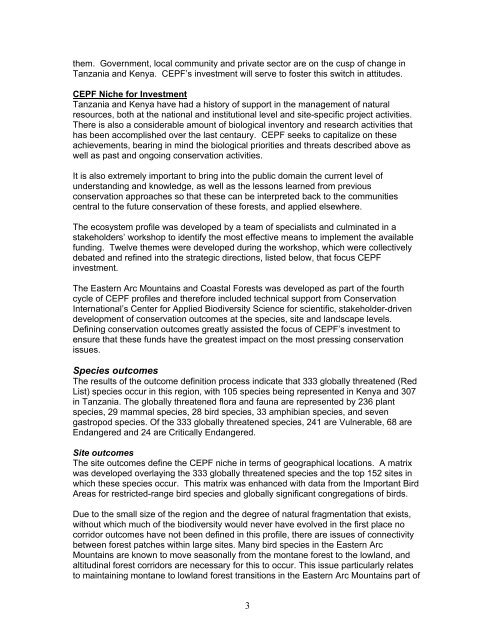Eastern Arc Mountains and Coastal Forests of Tanzania and Kenya ...
Eastern Arc Mountains and Coastal Forests of Tanzania and Kenya ...
Eastern Arc Mountains and Coastal Forests of Tanzania and Kenya ...
Create successful ePaper yourself
Turn your PDF publications into a flip-book with our unique Google optimized e-Paper software.
them. Government, local community <strong>and</strong> private sector are on the cusp <strong>of</strong> change in<strong>Tanzania</strong> <strong>and</strong> <strong>Kenya</strong>. CEPF’s investment will serve to foster this switch in attitudes.CEPF Niche for Investment<strong>Tanzania</strong> <strong>and</strong> <strong>Kenya</strong> have had a history <strong>of</strong> support in the management <strong>of</strong> naturalresources, both at the national <strong>and</strong> institutional level <strong>and</strong> site-specific project activities.There is also a considerable amount <strong>of</strong> biological inventory <strong>and</strong> research activities thathas been accomplished over the last centaury. CEPF seeks to capitalize on theseachievements, bearing in mind the biological priorities <strong>and</strong> threats described above aswell as past <strong>and</strong> ongoing conservation activities.It is also extremely important to bring into the public domain the current level <strong>of</strong>underst<strong>and</strong>ing <strong>and</strong> knowledge, as well as the lessons learned from previousconservation approaches so that these can be interpreted back to the communitiescentral to the future conservation <strong>of</strong> these forests, <strong>and</strong> applied elsewhere.The ecosystem pr<strong>of</strong>ile was developed by a team <strong>of</strong> specialists <strong>and</strong> culminated in astakeholders’ workshop to identify the most effective means to implement the availablefunding. Twelve themes were developed during the workshop, which were collectivelydebated <strong>and</strong> refined into the strategic directions, listed below, that focus CEPFinvestment.The <strong>Eastern</strong> <strong>Arc</strong> <strong>Mountains</strong> <strong>and</strong> <strong>Coastal</strong> <strong>Forests</strong> was developed as part <strong>of</strong> the fourthcycle <strong>of</strong> CEPF pr<strong>of</strong>iles <strong>and</strong> therefore included technical support from ConservationInternational’s Center for Applied Biodiversity Science for scientific, stakeholder-drivendevelopment <strong>of</strong> conservation outcomes at the species, site <strong>and</strong> l<strong>and</strong>scape levels.Defining conservation outcomes greatly assisted the focus <strong>of</strong> CEPF’s investment toensure that these funds have the greatest impact on the most pressing conservationissues.Species outcomesThe results <strong>of</strong> the outcome definition process indicate that 333 globally threatened (RedList) species occur in this region, with 105 species being represented in <strong>Kenya</strong> <strong>and</strong> 307in <strong>Tanzania</strong>. The globally threatened flora <strong>and</strong> fauna are represented by 236 plantspecies, 29 mammal species, 28 bird species, 33 amphibian species, <strong>and</strong> sevengastropod species. Of the 333 globally threatened species, 241 are Vulnerable, 68 areEndangered <strong>and</strong> 24 are Critically Endangered.Site outcomesThe site outcomes define the CEPF niche in terms <strong>of</strong> geographical locations. A matrixwas developed overlaying the 333 globally threatened species <strong>and</strong> the top 152 sites inwhich these species occur. This matrix was enhanced with data from the Important BirdAreas for restricted-range bird species <strong>and</strong> globally significant congregations <strong>of</strong> birds.Due to the small size <strong>of</strong> the region <strong>and</strong> the degree <strong>of</strong> natural fragmentation that exists,without which much <strong>of</strong> the biodiversity would never have evolved in the first place nocorridor outcomes have not been defined in this pr<strong>of</strong>ile, there are issues <strong>of</strong> connectivitybetween forest patches within large sites. Many bird species in the <strong>Eastern</strong> <strong>Arc</strong><strong>Mountains</strong> are known to move seasonally from the montane forest to the lowl<strong>and</strong>, <strong>and</strong>altitudinal forest corridors are necessary for this to occur. This issue particularly relatesto maintaining montane to lowl<strong>and</strong> forest transitions in the <strong>Eastern</strong> <strong>Arc</strong> <strong>Mountains</strong> part <strong>of</strong>3
















